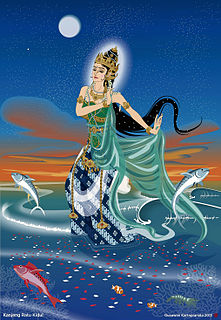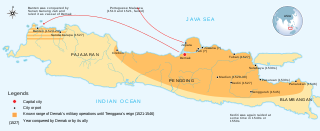
The kris or keris in the Indonesian and Malay languages, is an asymmetrical dagger with distinctive blade-patterning achieved through alternating laminations of iron and nickelous iron (pamor). Of Javanese origin, the kris is famous for its distinctive wavy blade, although many have straight blades as well, and is one of the weapons commonly used in the pencak silat martial art native to Indonesia, Malaysia, & Brunei.

The Sultanate of Mataram was the last major independent Javanese kingdom on the island of Java before it was colonised by the Dutch. It was the dominant political force radiating from the interior of Central Java from the late 16th century until the beginning of the 18th century.

Sultan Anyakrakusuma is known as Sultan Agung was the third Sultan of Mataram in Central Java ruling from 1613 to 1645. A skilled soldier he conquered neighbouring states and expanded and consolidated his kingdom to its greatest territorial and military power.

The Kingdom of Pajang or Sultanate of Pajang (1568–1586) was a short-lived Muslim state in Java. It was established by Hadiwijaya or Jaka Tingkir, Lord of Boyolali, after a civil war and was a successor to Sultanate of Demak. Hadiwijaya claimed to be a descendant of Brawijaya V, the last king of the Majapahit empire, and Trenggana, the sultan of Demak.

Amangkurat I was the susuhunan of Mataram from 1646 to 1677. He was the son of Sultan Agung of Mataram. He experienced many rebellions during his reign. He died in exile in 1677, and buried in Tegalwangi, hence his posthumous title, Sunan Tegalwangi or Sunan Tegalarum. He was also nicknamed as Sunan Getek, because he was wounded when suppressing the rebellion of Raden Mas Alit, his own brother.

Nyai Roro Kidul is an Indonesian Goddess of the sea. She is the Queen of the Southern Sea in Sundanese and Javanese mythology.

Sunan Kalijaga (1460-1513), born as Raden Mas Said son of a Duke of Tuban in East Java, Indonesia, was one of the "nine saints" of Javanese Islam. the "Kalijaga" title was derived from an orchard known as "Kalijaga" in Cirebon. Other accounts suggest the name derives from his hobby of submerging himself in Kali. Others note that the name Kalijaga derived its nature from the Arabic notion of qadli dzaqa which means "holy leader" in the sultanate.

The Demak Sultanate was a Javanese Muslim state located on Java's north coast in Indonesia, at the site of the present-day city of Demak. A port fief to the Hindu-Buddhist Majapahit kingdom thought to have been founded in the last quarter of the 15th century, it was influenced by Islam brought by Muslim traders from China, Gujarat, Arabia and also Islamic kingdoms in the region, such as Samudra Pasai, Malacca and Bani (Muslim) Champa. The sultanate was the first Muslim state in Java, and once dominated most of the northern coast of Java and southern Sumatra.

Demak is a regency located in the Indonesian province of Central Java, on northern coast of the island. It is bordered by Jepara regency and the Java Sea to the north, Kudus and Grobogan regencies to the east, Grobogan and Semarang regencies to the south, while to the west are Semarang Regency and the city of Semarang, to which the districts of Mranggen and Sayung are essentially suburban. The regency covers an area of 897.43 km2 (346.50 sq mi) and had a population of 1,055,579 at the 2010 Census; the latest official estimate is 1,162,805. It was originally the centre of the Demak Sultanate, once a dominant power in the region. Due to its strong relation with the spread of Islam in Java and the Wali Sanga, it is sometimes referred to with the nickname Kota Wali.
Sunan Ampel was one of the Javanese nine revered saints Wali Songo, credited for the spread Islam in Java. According to local history around Demak the mosque of Demak Masjid Agung Demak was built by Sunan Ampel in 1479 CE, but other source credited the construction of the mosque to Sunan Kalijaga.

The Sultanate of Cirebon was an Islamic sultanate in West Java founded in the 15th century. It is said to have been founded by Sunan Gunungjati, marked by his letter proclaiming Cirebon's independence from Pajajaran in 1482, although the settlement and the polity had been established earlier in 1445. Sunan Gunungjati also established the Sultanate of Banten. It was one of the earliest Islamic states established in Java, along with the Sultanate of Demak.

Kalinyamat Sultanate, Kalinyamat Kingdom or Jepara Kingdom, was a 16th-century Javanese Islamic polity in the northern part of the island of Java, centred in modern-day Jepara, Central Java, Indonesia.
Sultan Hadlirin or also known as Toyib of Kalinyamat, is the duke of Kalinyamat, a vassal of Demak Sultanate. He was dubbed as Sultan Hadlirin because he came to Jepara to propagate Islam in Java. Sultan Hadlirin's wife is the princess of Demak, the daughter of Demak Sultan Trenggana, Ratna Kencana, which popularly known as Ratu Kalinyamat.

Raden Patah, also known as Jin Bun (1455 in Jepara – 1518 in Demak) is the first sultan of Demak Sultanate. He became sultan in 1475, but the sultanate remained a vassal of Majapahit Empire until 1478. Raden Patah took the title Panembahan Jimbun after legitimizing the Sultanate of Demak as the successor of Majapahit Empire and his appointment as the sultan of Demak by Wali Sanga.
Pakubuwono I, uncle of Amangkurat III of Mataram was a combatant for the succession of the Mataram dynasty, in the First Javanese War of Succession.
Fatahillah was a commander of the Sultanate of Demak who is known for leading the conquest of Sunda Kelapa in 1527 and changing it name to Jayakarta. The conquest of Sunda Kelapa was one of his missions to spread Islam to West Java. He is a national hero in Indonesia.
Amangkurat III was a short-lived ruler of Susuhunan of Mataram, reigned 1703–1705.
The Duchy of Surabaya was a Javanese principality centered in Surabaya, on the northeastern coast of Java, that existed as an independent polity from c. 1546 to 1625. It became independent following the disintegration of the Demak Sultanate, and by the beginning of the 17th century had become the leading power in east Java and the most important port on Java's northeastern coast. Subsequently, it entered into decades of conflict with the Mataram Sultanate that ended in the victory of Mataram and the fall of Surabaya in 1625.

Panembahan Senapati, formally styled Panembahan Senapati ing Ngalaga Sayyidin Panatagama, was the founder of the Mataram Sultanate. His biography is discovered from traditional accounts, such as Javanese chronicles in the future era.

Giri Kedaton was an Islamic kedatuan located in Gresik, East Java and existed in the 15th to 17th centuries, until Giri was conquered by the Mataram Sultanate in 1636.











